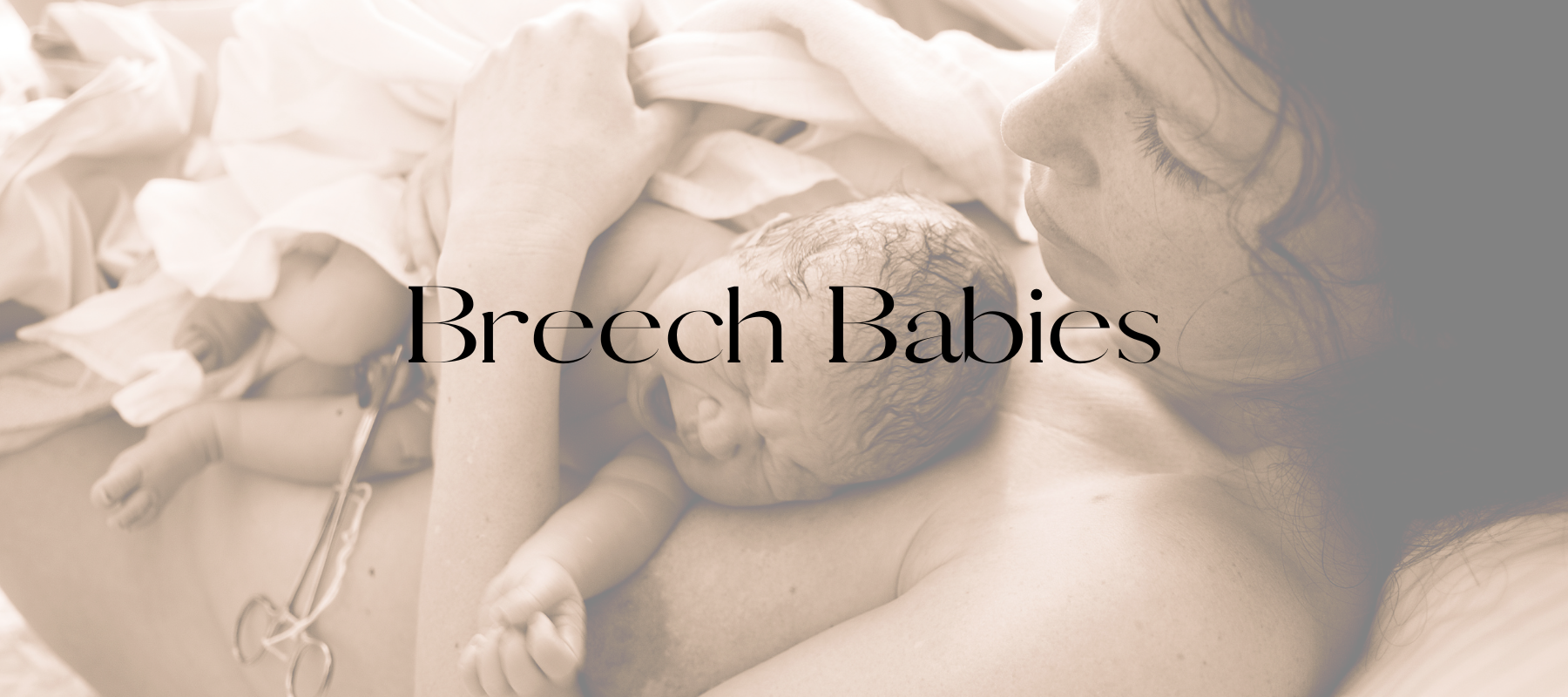What does "breech" mean?
The term breech refers to a birth position where the presenting part of the baby is the bottom, or feet, rather than the head. In a typical pregnancy, by the third trimester, a baby moves into a head down position, with their head near the birth canal and chin tucked in. This position is referred to as cephalic or vertex presentation and is the ideal position for a vaginal birth. However when a baby is positioned with their bottom or feet down and head is pushing up under the ribs, this is what we refer to as a breech position.
Up until around 36 weeks, it is considered normal for a baby to not be in the ideal birthing position. Until this point a baby still has plenty of time to flip to head down. If by 36 weeks a baby is still breech your healthcare provider may start discussing management and delivery options.
How common is breech presentation?
At 28 weeks: Around 25% of babies are breech
At 32 weeks: Around 7–10% are breech
At 37–40 weeks (term): 3–4% remain breech
Furthermore, following a previous breech delivery, the recurrence rate for the second pregnancy is nearly 10%, and for a subsequent third pregnancy, around 27%.
Types of breech presentations:
There are three types of breech positions that you may hear your healthcare provider talk about. These positions include Frank breech, complete breech and footling breech and each has its own implications for labor and birth:
- Frank Breech - The most common type of breech presentation making up for around 50-70% of term breech cases. The most common reason for frank breech is uterine shape or abnormalities including uterine fibroids, placenta previa and prematurity.
A frank breech baby presents with their bottom down toward the birth canal, legs extended straight up in front of their body and feet near or above their head.
Implications for birth:
Frank breech is considered the safest breech position for a vaginal delivery if criteria is met, particularly when under the care of highly skilled health professionals. Because the bottom is presenting and the hips are flexed with legs extended, the baby is more likely to fit down the birth canal more easily. Umbilical cord prolapse is also far less common with frank breech presentations when compared to the other types due to the baby’s extended legs preventing the umbilical cord from slipping down below the presenting part (the bottom).
-
Complete Breech - Just like with frank breech, the baby’s bottom is the presenting part, however knees are bent, often sitting cross-legged with feet pointing downward. This type of breech position is far less common and accounts for around 10% of total breech positions.
Implications for birth:
A complete breech may also be compatible with a vaginal delivery, though slightly less so than frank breech due to bulkier fetal presentation. It’s often more difficult to predict how easily the baby will pass through the birth canal and so an elective caesarean is often the preferred birthing method. Cord prolapse risk is moderate due to the cords ability to drop down between the legs so this will always be kept front of mind when caring for a parent with a complete breech baby.
- Footling Breech - With footling breech the feet are positioned downward ready to enter the birth canal first. It may be one foot (single footling) or both (double footling). This type of breech accounts for around 20% of breech births and comes with the most risks compared to the other two types. Most common in premature babies who haven’t yet turned but may also occur with polyhydramnios (too much amniotic fluid), uterine abnormalities, or multiple pregnancies.
Implications for birth:
Because the feet do not create a tight seal in the cervix, footling breach is not considered safe for vaginal delivery due to higher risk of cord prolapse, where the umbilical cord slips down into the birth canal before the baby, cutting off oxygen supply. Most commonly there would be a plan for a cesarean delivery.

How can you tell if your baby is breech?
You might suspect your baby is breech based on how and where you feel movement, especially if you've experienced a head-down pregnancy before. For instance, you may feel kicks lower in your pelvis rather than up near your ribs. You might also notice a firm lump (likely the baby’s head) under your ribs, instead of lower down in your abdomen.
Starting in the third trimester, your healthcare provider will begin palpating your abdomen during checkups to estimate your baby’s position. If they suspect the baby is breech before 36 weeks, there’s usually still time for the baby to turn on their own, and your provider will monitor progress before deciding on any next steps.
Why do some babies not turn to be head down?
There are many possible reasons why a baby might remain breech. Sometimes it's purely positional or mechanical, and other times there's a structural reason. Factors may include:
● Premature birth - baby hasn't had time to turn yet.
● Too much or too little amniotic fluid - affects how easily the baby can move.
● Uterine anomalies - like a bicornuate uterus, fibroids or uterine scaring.
● Placenta previa - placenta covering the cervix.
● Short umbilical cord - restricts baby's range of movement.
● Multiple gestation - twins or more = less room to flip.
● Baby’s head shape or size - sometimes babies with larger heads have less ability to turn when they are breech.
● Unknown causes – sometimes there's no identifiable reason
What tools can help a baby turn?
If your baby is in a breech position, your provider may explore options to encourage the baby to turn, especially if you’re hoping for a vaginal birth. Whether this is recommended depends on several factors, including your medical history, the details of your current pregnancy, and your birth preferences. In some situations, attempting to turn the baby may carry risks and might not be considered safe.
External Cephalic Version (ECV) -
An ECV is the most commonly used technique to try to turn a breech baby into a head-down position. This procedure is usually performed in a hospital by your maternity care provider. It involves applying firm but controlled pressure to your abdomen in an effort to guide the baby into a more favorable position while still in the uterus. During the ECV your doctor will utilize the ultrasound machine for guidance, they may also give you some medication to relax the uterus. Most women won't complain of too much pain, but it is generally uncomfortable.
While ECV can be effective, it does carry some risks and isn’t always successful. Your provider will assess whether it’s a safe option based on your specific pregnancy. If the baby turns successfully, you may be able to proceed with a vaginal birth. If the procedure is unsuccessful, your provider will likely recommend a planned cesarean section closer to your due date.
It’s not suitable for everyone, especially if:
● You have placenta previa
● You have low amniotic fluid
● You’re carrying multiples
● You’ve had a prior uterine rupture
*Important to note, although rare, there is always a small chance a baby can flip back after a successful ECV. In this case a caesarean would most likely be performed closer to your due date.
Spinning Babies:
If you're looking for gentle, proactive methods to help encourage your baby to turn, the spinning babies website is an evidence-based resource and is highly recommended by many midwives.
Some of the techniques advised include:
Daily - A sequence of stretches, movements, and posture practices to balance your body and pelvis.
Forward-Leaning Inversion - Helps create space in the lower uterus and stretch uterine ligaments.
Sidelying Release - Relaxes tight muscles that may be preventing the baby from moving.
Rebozo sifting – A gentle belly jiggle using a scarf or wrap (usually done with a partner).
While not a guarantee, many parents report that using these techniques consistently, especially between 30–36 weeks, encourages their baby to flip.
Other Supportive Practices:
● Prenatal bodywork (especially Webster technique). Ensuring the pelvis and body are aligned will give your baby more of a chance to be head down.
● Acupuncture and moxibustion - Used to relax the body and help encourage baby to turn.
● Swimming - Thought to help by relaxing the mothers muscles and creating more buoyancy for the baby to move freely.
● Pelvic tilts and hands-and-knees positions - trying to open the pelvis and allow space for the baby.
Birth options for a breech baby:
If your baby remains breech close to term, your care team will help guide you through safe delivery options. Your options may vary depending on your care provider and hospital policies.
Planned caesarean section:
This is the most common approach for breech births in many countries as it significantly reduces certain risks like cord prolapse or obstructed labour. Dependent on the care provider and the type of breech would depend on the planned caesarean being booked. Unfortunately with a caesarean birth comes a longer recovery time and some increased risks to future pregnancies (repeat caesarean, uterine rupture etc). It can also be a bigger psychological adjustment for some to go down this route if they were wanting a vaginal delivery.
Vaginal breech birth:
With an experienced provider and the right circumstances a vaginal delivery is still possible when a baby is breech. In order to be eligible for a vaginal delivery your baby should be in frank or complete breech position and have had no other pregnancy complications. Decisions should be made on a case to case basis and access to an emergency caesarean should always be available regardless of the birth plan.
Remember:
Surround yourself with skilled providers, ask questions, and trust your intuition. Give your body and your baby time to do what they need to do and remember there are ways to help a baby turn, but if they don't for any reason it is nothing you have done wrong. Breech is just a normal variation of birth, we just need to have a plan to support their safe arrival.
References:
Hannah, M. E., et al. (2000). Planned caesarean section versus planned vaginal birth for breech presentation at term: a randomised multicentre trial.
Royal College of Obstetricians and Gynaecologists (RCOG) Management of Breech Presentation ( 2017) Available at: https://www.rcog.org.uk/guidance/browse-all-guidance/green-top-guidelines/management-of-breech-presentation/
Royal Australian and New Zealand College of Obstetricians and Gynaecologists (RANZCOG) Breech Presentation at Term (2020) https://ranzcog.edu.au/statements-guidelines/
Spinning Babies. Resources on fetal positioning, daily activities, and breech techniques. Available at: https://www.spinningbabies.com
Shanahan, M. M., Martingano, D. J., & Gray, C. J. (2023). External Cephalic Version. StatPearls Publishing.



